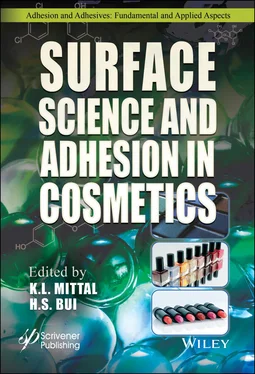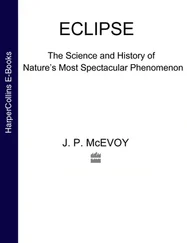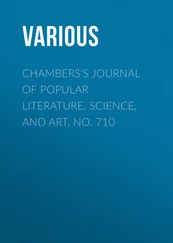Waxes are commonly characterized through melting temperature, optical transparency, thermal expansion coefficient, surface tension, surface free energy, hardness and melt viscosity. The molecular weight, molecular weight distribution, percentage of crystallinity and morphology of waxes play important roles in the crystallization and melting temperature and the hardness of the waxes. Table 2.3shows some physical properties of natural waxes for cosmetic application from wax suppliers [9] such as beeswax (BW), carnauba wax (CRW), candelilla wax (CLW), rice bran wax (RBW) and sun flower wax (SFW).
Table 2.3 Physical properties of typical natural waxes for cosmetic application [9].
| Natural wax |
Melting Temperature Tm (°C) |
Saponification value (mg KOH/g) |
Acid value (mg KOH/g) |
| Beeswax (BW) [9b] |
62-65 |
89-103 |
17-24 |
| Carnauba wax (CRW) [9b] |
80-86 |
78-95 |
2-7 |
| Candelilla wax (CLW) [9a] |
68-73 |
43-65 |
12-22 |
| Rice Bran wax (RBW) [9a] |
77-82 |
75-120 |
13 max |
| Sunflower wax (SFW) [9a] |
74-77 |
78-92 |
8 max |
The differential scanning calorimetric (DSC) data from Blake et al . [7] show single and narrow endothermic and exothermic peaks for SFW and RBW while CLW exhibits broader and multiple endothermic and exothermic peaks. These results indicate that SFW and RBW are chemically more homogeneous than CLW. Therefore, the crystallization and melting temperatures (T cand T m) are dependent on the chemical composition and melting point of dominant components in the wax. Figure 2.1shows the order of T cand T mof the natural waxes reported by Blake and coworkers [7, 8], wax suppliers [9] and by Dassanayake et al. , [10]. In addition, the order of the melting enthalpy for natural waxes [8] is observed to be dependent on their ester components as shown in Figure 2.2.
With complex chemical compositions and a wide range of melting temperatures, the natural waxes have many interesting properties that can be applied to develop many potential cosmetic products as seen in Table 2.4.
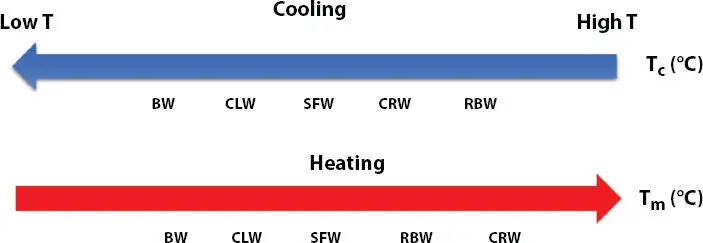
Figure 2.1 Order of crystallization and melting temperatures (T cand T m) of natural waxes.
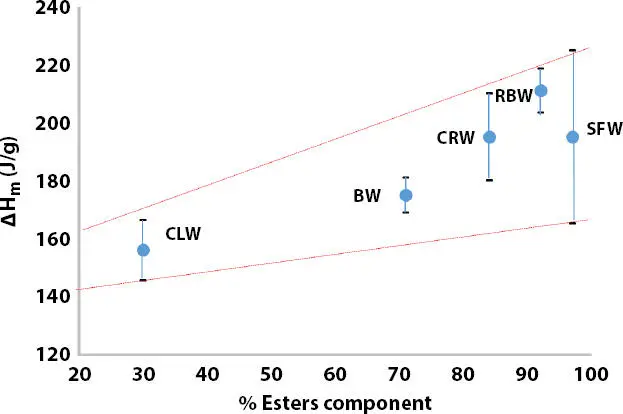
Figure 2.2 Dependence of melting enthalpy on esters component for natural waxes [8].
Table 2.4 Potential applications of natural waxes in cosmetics [9].
| Natural wax |
Properties |
Cosmetic application |
| Beeswax (BW) |
High binding strengthPlasticizerExcellent emulsifiabilityImproves structure, oil retentionGood depositMold release for stick applications |
Lipsticks Lip balms Mascara Hair styling Skincare cream |
| Carnauba wax (CRW) |
Hardest natural wax, provides good texture and stability due to high T mEnhances oil retentionHas emollient and moisturizing propertiesForms durable film to protect skin |
Lipstick Mascara Skincare cream Hair styling |
| Candelilla wax (CLW) |
Has good glossForms a durable film and a low coefficient of contraction. |
Lipstick Mascara |
| Rice Bran wax (RBW) |
Hard waxThickenerSilky and non-tacky feelPlasticizerInhibits syneresis |
Lipstick Creams Lotions Skincare cream Mascara Lip balms |
| Sunflower wax (SFW) |
Emulsifier and thickenerImproves oil bindingEmolliency, lubricityFilm formation |
Lipsticks Mascaras Lip balms Foundation Skincare cream |
Furthermore, waxes have been used in coatings, adhesives and inks to improve their adhesion to various substrates. The main advantage of using wax in the formulation is to improve the flexibility and extensibility of dried film. For example, the use of polyethylene wax (high T m) in the coatings to improve slip and rub resistance, and of paraffin wax (low T m) to reduce tack, improve slip and prevent tearing.
For developing a long-lasting of color lipstick, the rice bran wax has a potential to be used as gellant in the lipstick formulation since it can reduce the tack, or act as a plasticizer for high glass transition resins/film-formers or improve water repellency.
When using the long-wear lipstick, consumers feel their lips being dry over time. Therefore, they use the top coat containing oils to lubricate their lips for comfort. Sabale and coworkers [11] showed that rice bran wax could be used as occlusive moisturizer for skin. Thus, the rice bran wax can be used in the long-wear lipstick to maintain moisture for lips without the need to use the top coat. In addition, the high melting natural waxes such as rice bran, carnauba and sunflower waxes can enhance surface slip and rub resistance to improve the lasting of color of lipstick or mascara. Candelilla wax might be used in long-wear and non-transfer lipsticks to improve the shine/gloss and comfort after solvent evaporates. The use of carnauba and candelilla waxes in long-wear foundation can improve the stability of water/oil emulsion and reduce the film stickiness on the skin. Beeswax can be used as a wax dispersion in the cosmetic composition for skin and hair styling [12, 13]. Furthermore, Simonnet and coworkers utilized beeswax and a thermoplastic elastomer containing polystyrene in a dispersion form to improve the lasting of hair styling and the hair can be restyled for many cycles under thermal application [14]. In addition, beeswax dispersion was used with latex in semi-permanent mascara to enhance the volume of eyelashes and improve the removability of mascara with warm water [15]. Therefore, natural waxes have many potential applications in long lasting benefits in cosmetics and we need to explore them further.
2.3 Factors Affecting Oil-Wax Structures
When formulating a lipstick or any cosmetic stick with wax, the rigidity, the deposit and texture of the final products are dependent on the following factors:
Type of wax and concentration of wax
Polarity of oils
Viscosity of oils
Cooling rate
2.3.1 Factors Affecting Oil-Wax Structures: Wax Type
2.3.1.1 Non-Natural Waxes
To improve the structure of lipstick, Yoshida and coworkers [16] discovered that when a small amount of branched paraffin wax was added to a linear paraffin wax in ester oil, neopentyl glycol dicaprate, the hardness of the lipstick was enhanced. This behavior was from the reduction of the wax crystal size making the gel harder, but at the same time the crystal density decreased making the gel softer. To prevent the reduction of wax crystal density, they developed a branched wax, bis(polyethylenyl)-tetramethyldisiloxane, in which polyethylene (PE) units were at both ends. With the tetramethyldisiloxane at the center, it suppressed the crystal growth, but the PE end-units prevented the decrease of crystal density. Therefore, by adding this branched wax in the n-paraffin wax, the gel hardness increased dramatically. The benefit of this branched wax was to improve the hardness of the lipstick with lower amount of wax, which enhanced the gloss and gave creamy/smooth texture upon application.
To increase the hardness of oil-wax gel in a lower polarity oil, Imai and coworkers [17] blended 2 paraffin waxes with different carbon chain lengths (C30 and C32) in 1 to 1 ratio, and the gel was harder and rougher compared to the single paraffin wax gel, but still exhibited a single crystal phase as determined from X-ray diffraction (XRD). However, the blend of 2 paraffin waxes of carbon chain lengths C32 and C28 caused a macro-phase separation, resulting in a softer gel than from the blend of C30/C32 and the surface of crystals was smooth. This phenomenon was explained by the disorder of lamellar structures caused by the crystallization of 2 waxes with different carbon chain lengths as observed by SEM, small angle X-ray scattering (SAXS) and XRD measurements.
Читать дальше
